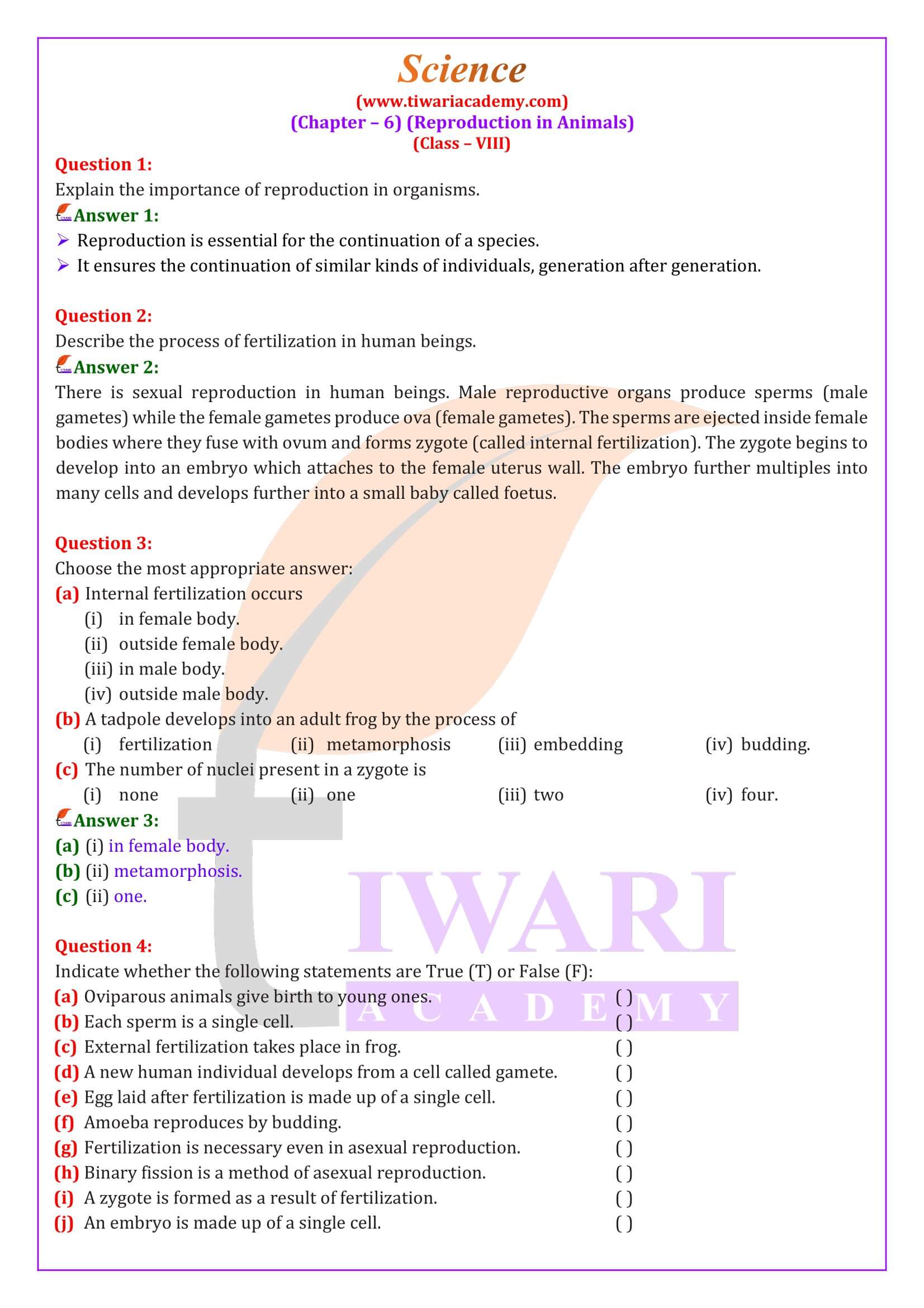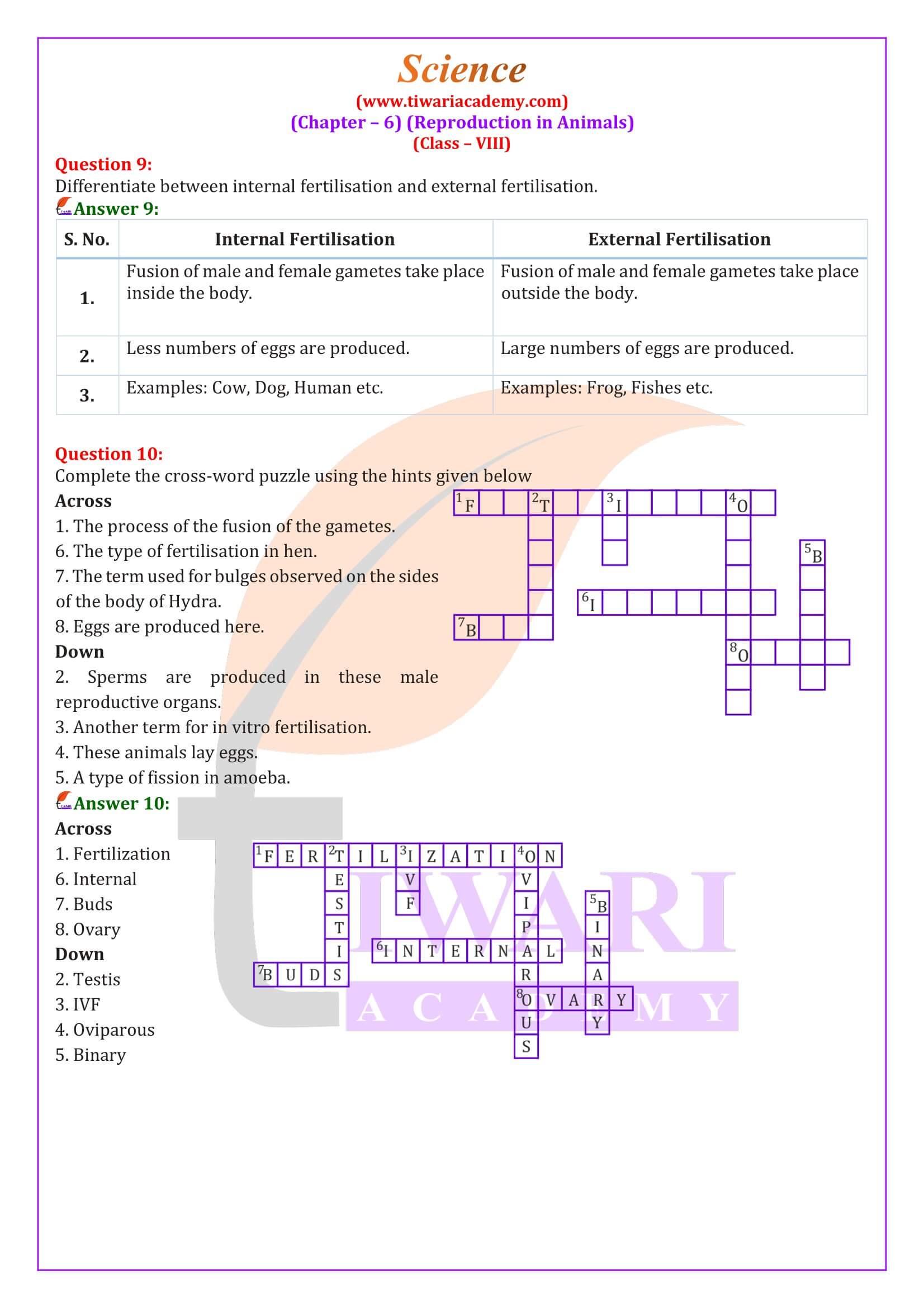Question Wise Class 8 Science Chapter 6 Solutions
Class 8 Science Chapter 6 NCERT Solutions
Class 8 Science Chapter 6 in Hindi Medium
Class 8 Science Chapter 6 Extra Questions
Class 8 Science Chapter 6 MCQ
Class 8 Science NCERT Book in PDF
Class 8 Science Chapter 6 Exemplar Book
Class 8 Science Chapter 6 Exemplar Answers
Class 8 Science NCERT Solutions
Class 8 all Subjects NCERT Solutions
NCERT Solutions for Class 8 Science Chapter 6 Reproduction in Animals Hindi and English Medium (Adhyay 6: Jantuon me Janan) to Study online or View in Video Format or download free in PDF file updated for new academic session 2025-26 based on new Books. The solutions of chapter 6 class 8 Science is based on new NCERT Books published for 2025-26 exams.
| Class: 8 | Science |
| Chapter 6: | Reproduction in Animals |
| Content: | MCQ, Practice Exercises and Answers |
| Session: | 2025-26 |
| Medium: | Hindi and English Medium |
Class 8 Science Chapter 6 in Hindi and English Medium
- Class 8 Science Chapter 6 Question Answers
- Class 8 Science Chapter 6 in Hindi Medium
- Class 8 Science Chapter 6 Extra Questions
- Class 8 Science Chapter 6 MCQ
- Class 8 Science Chapter 6 NCERT Book
- Class 8 Science Chapter 6 Exemplar Book
- Class 8 Science Chapter 6 Exemplar Answers
- Class 8 Science NCERT Solutions
- Class 8 all Subjects NCERT Solutions
Class 8 Science Chapter 6 Answers
NCERT Solutions for Class 8 Science Chapter 6 Reproduction in Animals is given below. Video Format solution and offline apps are also available for new academic session. Download 8 Science App for offline use updated for session 2025-26.
Class 8 Science Chapter 6 Solution and Explanation in Hindi
Class 8 Science Chapter 6 Solution and Explanation
Class 8 Science Chapter 6 Important Questions for Practice
What is metamorphosis? Give examples.
The transformation of the larva into an adult through drastic changes is called metamorphosis. Metamorphosis is a biological process which involves sudden and abrupt changes in the body structure of the animal by cell growth and differentiation. It is generally observed in amphibians and insects.
Examples: frogs and butterflies.
Give two difference between a zygote and a foetus.
Zygote is single cellular whereas foetus is a multicellular.
Well defined body parts are absent in zygote whereas in foetus body parts can be identified.
Describe the process of fertilization in human beings.
There is sexual reproduction in human beings. Male reproductive organs produce sperms (male gametes) while the female gametes produce ova (female gametes). The sperms are ejected inside female bodies where they fuse with ovum and forms zygote (called internal fertilization). The zygote begins to develop into an embryo which attaches to the female uterus wall. The embryo further multiples into many cells and develops further into a small baby called foetus.
Define asexual reproduction. Describe two methods of asexual reproduction in animals.
Asexual reproduction is a mode of reproduction in which only one parent is involved to reproduce offspring. In asexual reproduction, the offsprings produced are exact copies of their parents.
It is generally observed in very small sized organisms. Binary fission, Budding, Fragmentation etc. are the examples of asexual reproduction.
Budding: In this mode, a part of the organism starts bulging out. Slowly it grows and develops into a separate individual. Examples: Hydra, yeast.
Binary Fission: It is a type of asexual reproduction in which a single cell divides into two halves. Organisms that reproduce through binary fission are bacteria and Amoeba.
Class 8 Science Chapter 6 MCQ with Answers
1. Sets of reproductive terms are given below. Choose the set that has an incorrect combination.
(a) sperm, testis, sperm duct, penis
(b) menstruation, egg, oviduct, uterus
(c) sperm, oviduct, egg, uterus
(d) ovulation, egg, oviduct, uterus
2. In human beings, the correct sequence of events during reproduction is
(a) gamete formation, fertilisation, zygote, embryo
(b) embryo, zygote, fertilisation, gamete formation
(c) fertilisation, gamete formation, embryo, zygote
(d) gamete formation, fertilisation, embryo, zygote
3. In humans, the development of fertilised egg takes place in the
(a) ovary
(c) oviduct
(b) testis
(d) uterus
4. Animals exhibiting external fertilisation produce a large number of gametes. Pick the appropriate reason from the following.
(a) The animals are small in size and want to produce more offsprings.
(b) Food is available in plenty in water.
(c) To ensure better chance of fertilisation.
(d) Water promotes production of large number of gametes.
5. In human beings, after fertilisation, the structure which gets embedded in the wall of uterus is
(a) ovum
(c) foetus
(b) embryo
(d) zygote
6. Reproduction by budding takes place in
(a) hydra
(c) paramecium
(b) amoeba
(d) bacteria
7. Aquatic animals in which fertilisation occurs in water are said to be:
(a) viviparous without fertilisation.
(b) oviparous with external fertilisation.
(c) viviparous with internal fertilisation.
(d) oviparous with internal fertilisation.
8. In the list of animals given below, hen is the odd one out: human being, cow, dog, hen
The reason for this is
(a) it undergoes internal fertilisation.
(b) it is oviparous.
(c) it is viviparous.
(d) it undergoes external fertilisation.
9. After fertilisation, the resulting cell which gives rise to a new individual is the
(a) embryo
(c) foetus
(b) ovum
(d) zygote
10. Which of the following statements about reproduction in humans is correct?
(a) Fertilisation takes place externally.
(b) Fertilisation takes place in the testes.
(c) During fertilisation egg moves towards the sperm.
(d) Fertilisation takes place in the human female.
Answers of Important Questions (MCQ)
1 (c)
2 (a)
3 (d)
4 (c)
5 (b)
6 (a)
7 (b)
8 (b)
9 (d)
10 (d).




